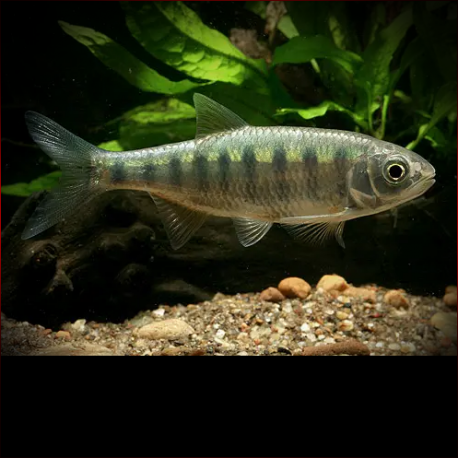More info
Datasheet
| Minimum Tank Size | 240 litres / 63.40 US gallons |
| Maximum Size | 10.0cm / 3.94inches |
| Temperature | 18°C / 64.40°F - 26°C / 78.80°F |
| Hardness | 2.02dgH / 36ppm - 12.05dgH / 215ppm |
| pH | 6.0-8.0 |
General Description
Opsarius infrafasciatus, previously considered synonymous with both O. ornatus and O. pulchellus, is a distinct species characterized by specific traits including a small caudal spot, anal-fin origin located opposite to the 4th-7th branched dorsal-fin ray and short or absent rostral and maxillary barbels. This fish is classified under the order Cypriniformes and belongs to the family Cyprinidae. The species primarily feeds on aquatic and terrestrial insects in its natural habitat.
Aquarium Setup
The ideal aquarium setup for O. infrafasciatus should mimic a flowing stream or river, featuring a substrate of variously sized rocks, sand, fine gravel, and water-worn boulders. Additional decorations such as driftwood roots and branches can be included to provide hiding spots. While most aquatic plants struggle in this setup, hardy varieties like Microsorum, Bolbitis, or Anubias can be attached to the decor. Maintaining pristine water conditions with high dissolved oxygen levels and moderate water movement is crucial. Regular water changes of 30-50% of the aquarium volume are recommended, along with the use of external filters, powerheads, and airstones. Due to their jumping behavior, a secure cover is essential for the tank.
Behaviour
O. infrafasciatus is unsuitable for community tanks due to specific environmental requirements and its tendency to outcompete or intimidate slower or less bold species during feeding. It is a fast swimmer and vigorous feeder, necessitating tankmates that are of similar size and robustness. This species is gregarious but forms shoals with a distinct pecking order, emphasizing the importance of keeping them in groups of five or more to prevent aggressiveness among individuals.
Feeding and Diet
In the aquarium, O. infrafasciatus can be fed a diet primarily consisting of high-quality dried foods supplemented with live or frozen options such as chironomid larvae (bloodworms), Artemia, chopped earthworms, gut-loaded Drosophila fruit flies, and small crickets. The species is known to prey on aquatic and terrestrial insects in the wild, with some small fishes and benthic invertebrates also likely part of its diet.
Reproduction & Dimorphism
Information regarding the reproduction of O. infrafasciatus is currently unreported. Sexual dimorphism is observed in this species, with nuptial males displaying visible breeding tubercles on the head and body, as well as more intense coloration compared to females. Female individuals tend to grow slightly larger and have a thicker body, especially when gravid.
Habitat and Distribution
Naturally distributed in the Ping River in Thailand, Ataran and Salween drainages in Myanmar and China, and tributaries of the Mekong in China, with its type locality recorded as the Metang River in northern Thailand, *O. infrafasciatus inhabits well-oxygenated, moderate to fast-flowing minor rivers with substrates of gravel, cobbles, boulders, and exposed bedrock. In the wild, it shares its habitat with various fish species such as Acanthocobitis, Botia, Schistura, Garra, Batasio, and Mastacembelus.

